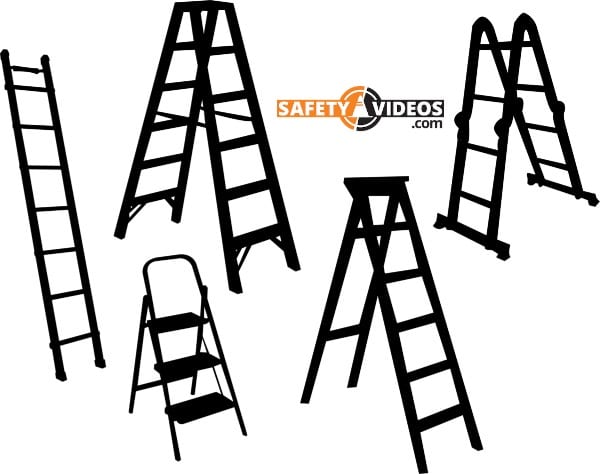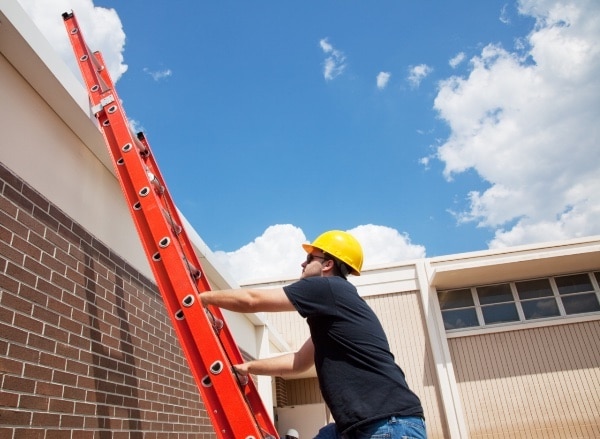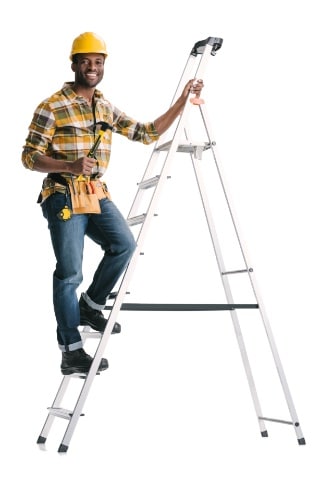How to Maintain a Ladder – Quick & Easy Tips

Whether at home or on the job, ladder safety is vital to avoid unnecessary injuries. Regularly inspecting and maintaining your ladder can save you from hospital visits.
A competent person always checks for signs of defective ladders before use to avoid accidental injuries.
Learn all you need to know about ladder safety and maintenance with our handy guide. This short write-up can be supplemented with our more in-depth ladder training program.
When Should You Inspect Ladders?
Before ever using a ladder every user should inspect a ladder for defects before each use. Although you don’t need a special credential or qualification, you always want a knowledgeable person to check ladders for safety violations or defects – improper inspection leads to unsafe use. Any average person can look at the ladder to understand whether it is ready and safe to use.
This will ensure that no one uses a ladder with structural damage and that it can support the user’s weight along with any equipment needed.
All rails, rungs, and other ladder parts must be secure and in good condition before climbing.

Choosing the Right Ladder
Aside from avoiding ladders with structural damage, ladders should be chosen according to the job.
Selecting a ladder specifically designed for your job will help you avoid injury. As a rule of thumb, it’s best to use apparatus that’s tall enough to where you won’t need to use the top three feet.
It would help if you also thought about a ladder’s duty rating. Choosing a model with the wrong load capacity could be detrimental and lead to injuries and the destruction of expensive equipment, especially on a day with high winds.
Consider how much your tools, materials, and equipment weigh in addition to your body weight while standing on it. In some cases, but not most, a ladder must be tied off to use it safely.
What to Do After Inspecting Ladders
- Protect wooden ladders with a clear sealer or wood preservative
- Replace frayed ropes on extension ladders
- Clean fiberglass ladders every three months and keep them out of the sun and other ultraviolet light sources.
- Lubricate pulleys on extension ladders regularly
- Label and take out of service any equipment that’s broken/ bent or has other defects
- Get rid of ladders that cannot be repaired safely
Checking for Damages on Metal and Wooden Ladders
Inspections should check for signs that it will support your weight and is structurally sound. The last thing you want is to fall off a tall ladder – these accidents can be fatal or lead to life-changing injuries.
If you see any items below, you should not attempt to make a temporary, makeshift repair and climb/use the ladder.
- Missing or loose rungs
- Missing identification labels
- Loose screws, nails, bolts, or other objects
- Damaged or lose slip feet/ platform
- Damaged hinges, springs, spreaders, ropes, or locking devices
- Rotting or distorted side rails in wooden ladders
- Cracks/damage in fiberglass ladders due to ultraviolet light sources
- Sharp edges on side rails and rungs
- Rust, corrosion, and oxidization (especially on treads)
- Splintered surfaces (especially on wood ladders)
- Wobbling (unstable bases)
- Loose or bent hinges and hinge spreaders
- Faulty spreaders
Look for the following items specifically for extension ladders:
- Defective cords, chains, and ropes
- Missing or faulty pads or sleeves
- Defective locks that do not set properly when the ladder is extended

What are 5 Ladder Rules That Should Be Followed for Safety?
Fall protection when using a step ladder is essential to stay safe. The following rules should help you stay safe when using ladders.
1. Inspect equipment before and after use
Inspection of every ladder before use is vital. However, you also want to check the ladder after using it too.
Once finished using it, you should check the rails, rungs, and other items to ensure they were not damaged during use. If they were, you should tag it and remove it, so no one else will use it.
2. Set up the ladder on a flat and stable surface
Find a level surface to place the ladder on to ensure it stays put. You can use leg levelers to eliminate wobbling if it has to be placed on an uneven surface. You need to ensure the base of the ladder is on a stable wall for portable ladder safety.
3. Set up in a safe place
Ladders need to be in a safe area away from hazards. The surrounding area must be clear of extra clutter for maximum safety. For example, ensure no spills on the floor and that electrical wires/ equipment are tucked away to avoid stumbling.
If possible, you should use wireless equipment to reduce the likelihood of accidents. You do not lean ladders near or over entryways where a door opens towards it.
4. Maintain overlap in extension ladders
With extension ladders, you must maintain an overlap, meaning each section should overlap the adjacent area by a minimum number of feet based on its general length.
For example, extension ladders up to 36 feet long overlap should be at least 3 feet. This will ensure your safety while climbing any extension ladder.
5. Climb and descend with caution
None of the above will help you avoid injury if you don’t make proper use of the ladder.
Here are a few things you need to remember when using a ladder:
- Only one person on a ladder at a time
- Avoid making sudden movements
- Don’t stand on the top cap
- Don’t use a ladder horizontally like a platform
- Don’t attempt to carry too many tools, materials, or equipment while on a ladder
- Avoid placing it on a gate or entryway whenever possible
- Wear protective clothing and gear (non-slip shoes)
Remember to stay near the center and face the ladder while gripping the side rails whenever you descend or climb. Wear a belt or hoist securely around your waist/hips to carry your tools safely.
Constantly hold three points of contact on the rails and rungs (one foot or two feet and two hands or one hand). Watch out for overhead power lines at all times to avoid electrical shock.

FAQ
What are the four main points of ladder maintenance?
- Tag and remove defective equipment.
- Keep extension ladders well-lubricated.
- Clean equipment regularly.
- Replace ropes when fraying becomes apparent.
What are the three ladder safety rules?
- No more than one person is on the ladder at any time.
- Never scale equipment that is on an uneven surface.
- Wear high-grip work boots.
When climbing a ladder, you should always maintain…
One foot and one hand on the ladder at all times! The more points of contact, the better.
Conclusion
Every year thousands of Americans are injured when working with ladders. Follow the tips above to avoid becoming a statistic!